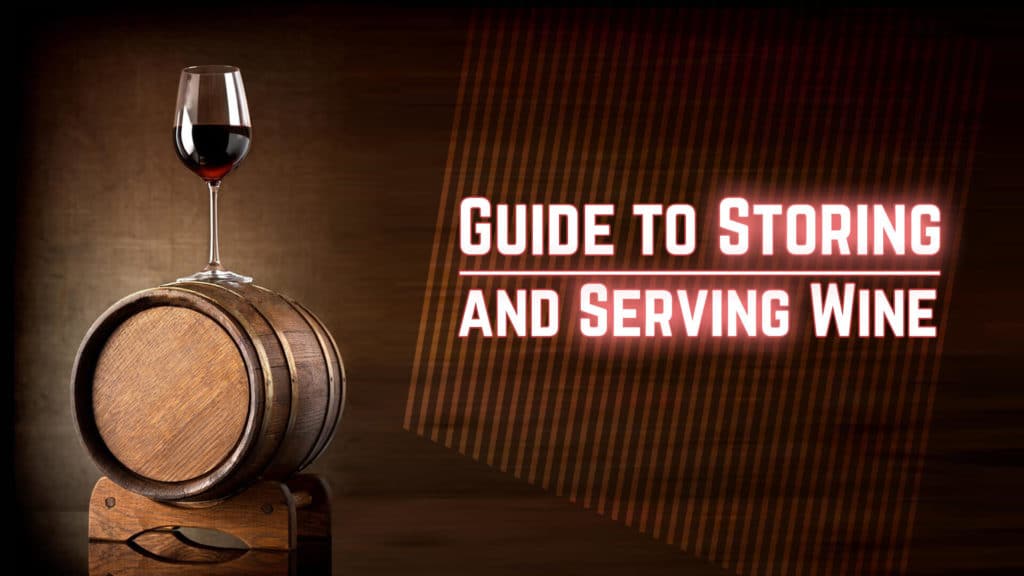Blog
Guide to Storing and Serving Wine
If you are developing a love affair with wine, chances are you are learning there is much more to a bottle of Chardonnay, Pinot Noir, or Cabernet Sauvignon than picking it up when you buy alcohol in Singapore and sipping it.
With every bottle comes a world of techniques that include tasting, pouring, and storing properly. Whether it is a cheap and cheerful bottle of fizz from California’s Central Valley or the best Burgundy has to offer, in this piece we are going to give you the rundown on how to take care of your wine like a pro.
Storing
Many people who a new to wine automatically find a place for their bottles in the kitchen. This is understandable as this is the room of food and drink merry-making. Also, many wine labels are so pretty, it is nice to have them on a shelf where you can see them.
Do not be tempted though. Unless it is a white chilling in the fridge, the kitchen is the worst place you can put any wine. This is because the temperature of the room fluctuates with the cooking that takes place there.
In order to remain in good shape, wine needs a cool and constant temperature of between 10 and 15 °C. Equally damaging, strong natural or artificial light can damage wine by heating it up and making it stale long before it should be.
A cool, dark place is best for your wine, but it does not have to be anything fancy. The bottom of a closet, underneath a chest of drawers, or in a corner of the basement will all work fine.
Finally, if your wine has a cork, lie it on its side while it is in storage. The contact with the wine means the cork will not dry out and allow air to enter the bottle leading to oxidation. If your wine has a screw cap, you can stand it upright if that is more convenient for your available space.
Serving Wine
We all know warm beer is a sign of a poor welcome and the same could be said for wine. The serving temperature of wine depends on the style you are drinking. A full-bodied red will not taste its best if served at a temperature that is ideal for Moscato d’Asti.
Likewise, a light white wine will be undrinkable if you serve it at a temperature that is better suited to an Amarone della Valpolicella. What is the ideal service temperature of different styles of wine?
Sweet Wines
We all love a drop of sweet Sauternes or Eiswein once in a while but what a waste if they are served at the wrong temperature. These wines are fine and costly so make sure you get the service right. Serve these wines well-chilled at 6 to 8°C.
Sparkling Wines
Nobody wants to drink bubbly that has not been chilled properly. Sparkling wines like Champagne, Sekt, Cava, Asti, Prosecco, and all the other fizz we love, should be served at 6 to 10°C to be bright and festive in the glass.
Light to Medium-Bodied White Wines
Wines that fall into this category include Muscadet, New Zealand Sauvignon Blanc, Pinot Grigio, and Fino Sherry. The optimal serving temperature for such relatively delicate wines is 7 to 10°C.
Medium, Full-Bodied, Oaked White Wines
Heavyweight whites like White Burgundy and Fumé Blanc fall into this category. They need some chill but not so much that their finer aromas and flavors are frozen out. Serve at 10 to 13°C.
Light-Bodied Reds
Think Beaujolais, Pinot Noir, Gamay, and Grenache for reds that have a light body. Serve these slightly chilled at 13°C.
Medium to Full Bodied Wines
With their lush aromas and big palates, bold reds are a joy to savor when they are served at the correct temperature. It is important to get this right as rich reds are beautiful when they unfurl and reveal their layers.
Perhaps the easiest of all wines to serve, these styles need a room temperature of 15 to 18°C. Wines in this category include but are not limited to Red Bordeaux, Rioja, Sagrantino, New World Shiraz, Vintage Port, and Barolo.
Getting it Right
Like anything in the world of wines and spirits, the more you know the greater your enjoyment of what is in your glass. However, it is all very well knowing what serving temperatures suit different wines but are you supposed to use a thermometer every time you have wine on the menu?
The answer is yes. There are different types of wine thermometers so you can go for the one that suits you best. Two examples are the collar thermometer and the temperature probe.
The former is placed around the neck of the wine bottle to give a reading while the second is inserted into a bottle or glass to get an accurate temperature level.
There are other snazzy, new-fangled wine temperature readers as well. You simply need to shop around to see what suits you. That just leaves us to say, enjoy your wine, and even more so when it is at the right temperature!



